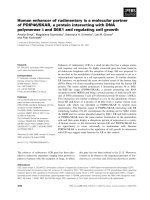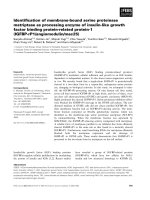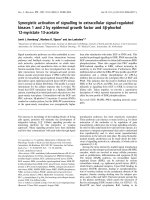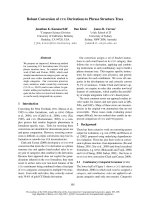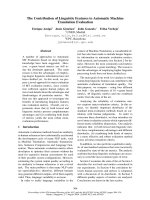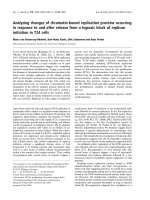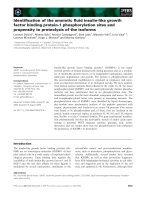Báo cáo khoa học: "Growth response of Populus hybrids to flooding" pps
Bạn đang xem bản rút gọn của tài liệu. Xem và tải ngay bản đầy đủ của tài liệu tại đây (694.88 KB, 12 trang )
Original
article
Growth
response
of
Populus
hybrids
to
flooding
S.W.
Hallgren*
INRA,
station
d’amelioration
des
arbres
forestiers,
Ardon,
45160
Olivet,
France
(received
25
September
1988;
accepted
27
February
1989)
Summary —
The
growth
responses
to
flooding
of
19
Populus
clones
representing
crosses
among
7
species
from
3
sections
were
studied
under
controlled
conditions.
Softwood
cuttings
were
grown
in
a
greenhouse
and
subjected
to
three
treatments,
well
watered
and
flooded
to
10
or
5
cm
below
the
soil
surface,
for
12
weeks
from
July
to
November.
Root
growth
was
severely
reduced
by
flooding
and
stem
growth
was
unaffected
for
some
clones
and
increased
in
others.
Consequently,
clonal
mean
dry
matter
production
for
flooded
soils
ranged
from
107
percent
to
62
percent
of
the
control.
The
capacity
to
grow
roots
in
waterlogged
soil
was
associated
with
dry
weight
production
in
flooded
soil.
Aigeiros
hybrids
and
the
intersectional
hybrids
Tacamahaca
x
Aigeiros
showed
higher
resistance
to
waterlogged
soils
than
Tacamahaca
hybrids.
Leuce
hybrids
showed
a
wide
range
of
responses
and
the
P.
tremula
x
P.
tremuloides
hybrids
ranked
high
for
capacity
to
grow
roots
below
the
water
table.
Flooding
caused
all
the
clones
to
develop
morphological
traits
associated
with
oxygen
transport
to
submerged
roots :
stem
hypertrophy,
hypertrophied
lenticels
on
the
stem
and
roots,
oxidation
of
the
rhizosphere
and
increased
root
porosity.
waterlogged
soil -
root
porosity -
resistance -
roots -
morphology
Résumé —
Comportement
d’hybrides
de
Populus
en
sol
ennoyé.
L’objectif
de
l’étude
était
de
comparer
le
développement
et
l’adaptation
de
clones
de
Populus
dans
des
conditions
simulées
d’hydromorphie
édaphique,
pour
apporter
aux
sélectionneurs
une
technique
précoce
de
prédiction
de
l’adaptation
des
clones
aux
sols
hydromorphes.
Dix-neuf
clones,
hybrides
interspécifiques,
dont
les
parents
appartiennent
à
7
espèces
des
3
sections
principales
utilisées
en
populiculture -
Aigeiros,
Tacamahaca
et
Leuce
-,
ont
été
utilisés
(Tableau
I).
L’essai
s’est
déroulé
en
serre.
Des
boutures
herbacées
ont
été
installées
dans
un
sub-
strat
de
texture
limoneuse,
inclus
dans
des
conteneurs
d’un
volume
intérieur
d’un
litre.
Elles
ont
été
soumises
à
3
régimes
hydriques :
bon
drainage
(témoin),
niveau
d’eau
à
10
cm
de
la
surface
du
sol,
niveau
à
5
cm.
L’ennoiement
a
été
maintenu
pendant
12
semaines,
de
mi-juillet
à
mi-
novembre. A
l’issue
de
cette
période,
les
observations
suivantes
ont
été
réalisées :
accroissement
aérien
et
souterrain,
modifications
morphologiques
et
porosité
racinaire.
Du
fait
d’une
différence
de
croissance,
avant
l’ennoiement,
les
clones
ont
été
séparés
en
deux
groupes,
pour
l’analyse
des
résultats.
Le
premier
contenait
les
clones
à
enracinement
rapide.
Le
second,
ceux
dont
l’enra-
cinement
était
retardé
d’environ
une
semaine
par
rapport
aux premiers.
*
Present
address :
Department
of
Forestry,
Oklahoma
State
University.
Stillwater,
OK
74078,
USA.
Les
clones
ont
montré
une
tolérance
remarquable
à
l’excès
d’eau.
Ils
n’ont
eu
aucune
mortalité.
La
croissance
de
certains
d’entre
eux
a
été
augmentée,
ou,
à la
ligueur,
seulement
légèrement
diminuée,
par
rapport
au
témoin
(Tableau
11).
En
majorité,
les
clonss
ont
modifié
la
répartition
de
leur
biomasse.
Si
leur
développement
était
réduit,
ils
l’ont
équilibré
en
augmentant
la
biomasse
de
leur
partie
aérienne
et
des
boutures
originelles
(Figs
1 et
3).
En
conséquence,
la
biomasse
sèche
totale
n’a
pas
été
affectée
par
l’ennoiement
pour
les
clones
du
Groupe
1.
Pour
ceux
du
Groupe
2,
la
réduction
de
biomasse
a
été
moins
importante
que
prévu,
malgré
la
forte
diminution
de
la
crois-
sance
racinaire.
En
général,
la
productivité
des
clones
était
directement
liée
à
l’aptitude
de
leurs
racines
à
croître
dans
les
horizons
ennoyés
(Tableaux
Il
et
III,
Fig.
3).
Dans
le
G’roupe
1, un
clone
de
P.
alba
(clone 1)
et
les
hybrides
intersectionnaux
Unal
et
Beaupré
(clones
5
et
4),
considérés
comme
peu
adaptés
aux
sols
hydromorphes,
ont
eu
une
croissance
racinaire
,exceptionnelle
sous
le
niveau
d’eau
et
sont
classés
parmi
les
meilleurs
sur
le
plan
de
la
biomasse
produite
en
milieu
ennoyé. A
l’opposé,
des
clones
souvent
recommandés
pour
des
sols
insuffisamment
drainés,
comme
les
clones
de
la
section
Tacamahaca,
Fritzi
Pauley
et
Androscoggin
(clones 2
et
3)
se
sont
mal
com-
portés
en
sol
ennoyé.
Dans
le
Groupe
2,
les
clones
Aigeiros
Robusta
et
I 214
(clones
6
et
7)
se
sont
comportés
d’une
façon
exceptionnelle
en
sol
ennoyé.
Pourtant
ils
ne
sont
pas
connus
pour
leur
adaptation
aux
sols
hydromorphes.
Les
4
hybrides
de
la
section
Leuce,
chez
lesquels
P.
tremuloides
a
été
croisé
avec
P.
alba
(clones
13
et
14)
ou
P.
tremula
(clones
15
et
16)
se
sont
très
lJien
comportés
en
sol
ennoyé.
Ceci
est
en
partaite
concordance
avec
ce
que
l’on
sait
de
leurs
performances
en
sol
hydromo
l
phe.
Comme
dans
le
Groupe
1,
les
clones
de
la
section
Tacamahaca,
P.
trichocarpa
et
P.
maximowiczü
(clones
17
et
18)
ont
eu
un
mauvais
comportement
en
sol
ennoyé.
L’ennoiement
a
provoqué,
chez
tous
les
clones,
des
développements
morphologiques
associés
au
transport
de
l’oxygène
vers
les
racines
noyées :
hypertrophie
de
la
tige
et
des
lenticelles
de
tiges
et
de
racines,
oxydation
de
la
rhizosphère
et
augmentation
de
la
porosité
racinaire.
Ces
travaux
devraient
être
complétés
pour
déterminer
comment
les
clones
se
comportent
en
milieu
forestier
dont
l’hydromorphie
due
à
l’excès
d’eau
hivernal
est
souvent
combinée
à
une
sécheresse
estivale.
sol
hydromorphe -
porosité
racinaire -
résistance -
racine -
mo! phologie -
test
précoce
INTRODUCTION
Millions
of
hectares
of
land
have
management
restrictions
due
to
excess
soil
water;
these
areas
are
not
only
along
rivers
but
also
in
uplands
with
poor
drainage.
Such
land
is
usually
managed
for
forestry
purposes,
as
it
is
inappropriate
for
agriculture.
The
problems
caused
by
flooding
place
severe
restrictions
on
forest
productivity,
and
the
success
of
forestry
in
flood-prone
areas
depends
on
selection
of
the
right
species
and
silvicultural
treat-
ments
for
the
site.
The
most
important
constraint
for
trees
growing
in
waterlogged
soils
is
the
lack
of
oxygen
which
can
become
complete
within
hours
of
flooding
due
to
displace-
ment
of
gas
by
water,
reduced
diffusion
of
oxygen
and
depletion
of
oxygen
by
micro-
organisms
(Scott
&
Evans,
1955;
Coutts
&
Armstrong,
1976).
Secondary
effects
of
flooding
are
the
production
by
roots
of
toxic
substances
such
as
ethanol
(Fulton
&
Erickson,
’
1964;
Keeley,
1979)
and
cyanogenic
compounds
(Rowe
&
Catlin,
1971)
and
the
development
of
soil
toxins
due
to
reducing
conditions
(Jones,
1972;
Ponnamperum;a,
1972).
The
type
and
degree
of
damage
depends
on
the
tree
species,
age,
and
phenological
state
and
on
the
soil
type
(Coutts
&
Armstrong,
1976;
Kozlowski,
1982).
Some
tree
species
are
killed
by
as
little
as
24
hours
of
flooding
and
others
can
withstand
continuous
flooding
for
as
long
as
4
years
(Crawford,
1982).
Adaptations
to
flooding
include
development
of
aerenchyma
(Yu
et
al.,
1969;
Jat
et
al.,
1975;
Coutts
&
Armstrong,
1976;
Harrington,
1987)
for
maintenance
of
oxygen
supply
to
flooded
roots
and
alternative
metabolism
for
growth
and
maintenance
under
anoxia
(Keeley,
1979;
Crawford,
1982).
Several
species
of
Populus
are
recommended
for
forestry
in
areas
that
have
poor
drainage
or
are
subject
to
flooding
because
they
are
recognized
as
being
tolerant
to
waterlogged
soils
(Food
and
Agriculture
Organization
of
the
United
Nations,
1980;
Soul6res,
1984).
However,
the
nature
of
the
tolerance
to
flooded
soils
has
not
been
studied
and
there
is
little
information
about
which
species
or
clones
perform
best
under
flooding.
The
objective
of
the
present
study
was
to
compare
the
adaptation
and
development
of
various
Populus
clones
under
controlled
condi-
tions
of
simulated
waterlogged
soils.
The
ultimate
goal
was
to
provide
information
concerning
resistance
to
waterlogged
soils
that
could
be
used
to
develop
selection
criteria
for
tree
improvement
programs.
MATERIALS
AND
METHODS
A
total
of
19
clones
representing
7
species
from
3
sections
(Table
I)
were
included
in
the
study.
They
represent
a
range
of
capacity
to
withstand
waterlogged
soils
based
on
empirical
know-
ledge,
and
there
is
interest
in
using
them
in
forest
plantations
where
flooding
occurs.
Some
of
the
clones
are
already
widely
used
in
intensive
culture.
Softwood
cuttings
were
taken
from
new
growth
in
early
June
and
trimmed
to
a
length
of
10
to
15
cm
and
a
constant
leaf
area
(one
to
two
leaves
depending
on
the
clone).
The
stem
cuttings
were
poked
into
flats
of
a
peat-
vermiculite
mixture
and
placed
in
a
greenhouse
until
roots
developed.
When
most
of
the
stem
cuttings
for
a
clone
developed
roots
they
were
separated
and
transplanted
into
1.5
litre
(dia-
meter
9
cm
and
height
26
cm)
plastic
bottles
(1
cutting
per
bottle)
from
which
the
tops
had
been
removed.
The
bottles
had
three
drainage
holes
and
2
cm
of
gravel
in
the
bottom
and
were
enclosed
in
black
plastic.
They
were
filled
with
a
loamy
sand
collected
along
a
stream
on
the
property
of
the
Centre
de
Recherche
d’Orleans.
Particle
size
distribution
for
the
soil
was
6%
clay,
17%
silt,
and
77%
sand.
The
organic
matter
content
was
6.7%.
The
transplants
were
transferred
to
a
greenhouse
where
the
treat-
ments
were
applied.
As
each
clone
developed
roots
at
a
different
rate,
9
days
were
required
to
transplant
all
the
clones.
Flooding
treatments
were
begun
15
days
after
the
last
clone
had
been
transplanted.
Therefore,
the
period
of
establishment
in
the
bottles
ranged
from
23
to
22
days
for
5
clones
to
15
to
17
days
for
14
clones.
The
treatments
consisted
of
an
unflooded
control
and
flooding
to
10
cm
and
5
cm
below
the
sol
surface
(-10
0
cm
and
-5
cm).
The
bottles
were
placed
in
waterproof
containers
that
were
filled
with
water
to
the
specified
level
by
an
automatic
irrigation
system.
In
order
to
replace
water
lost
to
evaporation
and
transpiration
the
water
level
was
brought
up
to
the
treatment
level
3
times
each
day.
The
entire
experiment
was
watered
with
a
sprinkler
as
needed
to
maintain
adequate
moisture
in
the
unflooded
control.
Treatments
were
arranged
in
a
split-plot
design
with
flooding
treatments
as
the
whole
plots
and
clones
as
sub-plots.
There
were
three
replicates.
Each
clonal
sub-plot
contained
3
bottles.
Treatments
were
begun
on
July
18th
and
terminated
when
the
seedlings
were
harvested
in
October
and
early
November.
Each
of
the
plants
was
measured
for
dry
weight
of
the
new
stem,
original
stem
cutting
and
roots.
The
leaves
had
already
begun
to
fall
and
were
not
measured.
The
bottles
were
cut
horizontally
into
5
cm
long
sections.
Roots
were
extracted
from
the
soil
for
each
5
cm
increment
of
soil
depth
and
measured
for
dry
weight.
Observations
were
made
of
the
condition
of
the
roots
and
stems
of
each
plant,
including
discoloration,
oxidation
of
the
rhizosphere,
lenticel
development
and
stem
hypertrophy.
Root
porosity
was
measured
for
the
portion
of
roots
in
the
10
to
15
cm
deep
soil
segment
for
the
control
and
the
-10
cm
flooding
treatment
according
to
established
techniques
(Jensen
et al.,
1969;
Yu
et al.,
1969;
Luxmoore
et
al.,
1972).
Root
porosity
measurements
were
only
made
for
clones
2, 4, 12, 15,
and
19.
Response
indices
for
total
dry
weight
and
for
the
dry
weight
of
roots
below
and
above
the
water
table
were
calculated
as
the
plot
mean
for
a
flooding
treatment
divided
by
the
plot
means
for
its
control.
Preliminary
analysis
showed
that
the
clonal
response
index
for
total
dry
weight
for
the
-5
cm
treatment
was
significantly
correlated
with
date
of
transplanting;
therefore,
the
data
were
divided
into
two
groups
for
separate
analyses.
Group
1
comprised
clones
1-5
with
22
to
23
days
of
establishment
and
Group
2
comprised
clones
6-19
with
15
to
17
days
of
establishment
before
beginning
treatments.
Analysis
of
variance
was
used
to test
the
significance
of
treatment
and
clonal
effects.
The
least
significant
difference
test
and
Duncan’s
multiple
range
test
were
used
to
test
for
significant
differences
at
the
5
percent
level
among
treatments
and
clonal
means,
respec-
tively
(Steel
&
Torrie,
1980).
RESULTS
Dry
Matter
Allocation
Clones
in
Group
1
showed
flooding
to
- 10
cm
significantly
reduce
root
weight
by
14%
and
increased
both
the
original
stem
cutting
and
new
stem
dry
weight
by
30%
(Fig.
1
Flooding
to
-5
cm
reduced
root
weight
by
60%,
and
increased
to
original
stem
cutting
and
new
stem
weight
by
43
and
60%,
respectively.
In
contrast,
Group
2
clones
showed
flooding
to
-10
cm
reduced
total
plant
weight
by
11
%
and
root
weight
by
31%.
Flooding
to
-5
cm
reduced
total
plant
by
34%
and
root
weight
by
72%.
Both
flooding
treatments
increased
the
original
stem
cutting
dry
weight
by
21 %.
The
height
growth
response
to
the
flooding
treatment
was
essentially
the
same
as
the
response
of
stem
dry
weight.
At
the
start
of
the
treatment
average
height
was
15.3
and
21.6
cm
for
Groups
1
and
2.
Treatment
effects
on
height
growth
were
significant
in
Group
1.
Average
height
growth
was
25.5,
29.8
and
34.3
cm
for
the
control,
-10
cm
and
-5
cm
treatments,
respectively.
In
Group
2
the
average
height
growth
was
26.3
cm
and
the
treatment
showed
no
effect.
Flooding
altered
the
allocation
of
dry
weight
to
roots,
original
stem
cutting
and
new
stems
(Fig.
2).
In
both
groups
of
clones
the
proportion
of
dry
weight
allocated
to
roots
declined
from
54%
in
the
control
to
23%
in
the
most
severe
flooding
treatment.
Correspondingly,
mean
allocation
to
the
original
stem
cutting
and
to
the
new
shoot
was
increased
under
flooding.
The
response
index
for
total
dry
weight
was
significantly
different
among
clones
in
Group
2
but
not
in
Group
1.
As
the
response
index
did
not
show
a
significant
(1)
Within-groups
means
followed
by
the
same
letter
are
not
different
at
the
5%
level.
(See
Table
I for
clone
identification).
interaction
between
treatment
and
clone
for
either
group,
indexes
were
averaged
over
both
flooding
treatments
to
show
clonal
differences
(Table
II).
The
average
response
index
ranged
from
1.07
to
0.89
for
Group
1
and
from
0.95
to
0.62
for
Group
2
(Table
II).
The
Aigeiros
hybrids
Robusta
and
1214
(clones
6
and
7)
showed
above
average
performance
while
the
Tacamahaca
clones
36-134
and
12-150
(clones
17
and
18)
showed
below
average
performance.
Among
the
Leuce
hybrids
(clones
8-16
in
Group
2),
which
showed
the
full
range
of
response
indices,
both
P.
alba
x
P.
tremuloides
hybrids
(clones
13
and
14)
showed
high
perform-
ance.
The
response
indices
for
the
inter-
sectional
hybrids
(Tacamahaca
x
Aigeiros)
were
high
for
Beaupré
and
Unal
(clones
4
and
5)
in
Group
1
and
low
for
Roxbury
(clone
19)
in
Group
2.
Root
Growth
Root
growth
in
the
soil
below
the
water
table
was
greatly
reduced
by
flooding.
The
average
response
index
for
root
dry
weight
below
the
water
table
for
both
groups
was
0.12
and
0.08
for
the
-10
and
-
5 cm
treatments.
In
contrast,
root
growth
above
the
water
table
was
increased.
Group
1
clones
showed
an
average
response
index
for
root
dry
weight
above
the
water
table
of
1.72
and
1.96
for
the
- 10
and
-5
cm
treatments.
Corresponding
values
for
Group
2
were
1.24
and
1.31.
Clonal
differences
in
response
index
for
root
dry
weight
above
and
below
the
water
table
were
similar
for
the
two
flooding
treatments
and
consequently
only
the
values
for
the
-10
cm
treatment
are
reported
here
(Table
III).
Clones
in
Group
1
showed
significant
differences
in
root
growth
response
index
below
the
water
table
but
not
above,
In
contrast,
Group
2
clones
showed
significant
differences
below
and
above
the
water
table.
Clonal
values
for
the
response
index
for
root
dry
weight
below
the
water
table
ranged
from
0.01
to
0.22
(Table
111).
The
Aigeiros
hybrids
Robusta
and
1214
(clones
6
and
7)
ranked
highest
in
Group
2.
The
Tacamahaca
hybrids
Fritzi
Pauley
and
Androscoggin
(clones
2
and
3)
ranked
lowest
in
Group
1.
Also,
in
Group
2
the
Tacamahaca
clones
36-134
and
12-150
(clones
17
and
18)
showed
poor
performance.
Leuce
hybrids
showed
a
wide
range
of
responses.
In
Group
1
the
P.
alba
clone
605-3B8
(clone
1)
ranked
highest.
In
Group
2
two
P.
tremula
x
P.
tremuloides
hybrids
327-1
and
310-8
(clones
15
and
16)
ranked
high;
Again
the
response
indexes
for
the
intersectional
hybrids
ranged
from
high
for
Unal
(clone
5)
to
low
for
Roxbury
(clone
19).
The
rankings
of
the
clones
were
somewhat
different
for
the
response
index
for
root
dry
weight
above
the
water
table
(Table
III).
Nonetheless,
in
Group
2
the
Aigeiros
hybrid
Robusta
(clone
6)
ranked
among
the
highest
and
the
Tacamahaca
clone
12-150
(clone
18)
ranked
low.
The
Leuce
hybrids
again
showed
a
wide
range
of
responses.
Flooding
altered
the
distribution
of
roots
with
depth
(Fig.
3).
Root
growth
in
the
control
treatment
was
well
distributed
through
the
entire
soil
depth.
In
contrast,
flooding
severely
limited
root
penetration
below
the
water
table.
Deep
root
penetration
below
the
water
table
was
shown
by
the
intersectional
hybrid
Unal
(clone
5)
in
Group
1
and
Leuce
and
Aigeiros
hybrids
310-8
and
Robusta
(clones
16
and
6)
in
Group
2.
Root
penetration
was
severely
limited
for
the
Tacamahaca
hybrids
12-150
and
Androscoggin
(clones
18
and
3)
in
both
groups.
Morphology
Flooding
did
not
cause
any
mortality,
but
it
did
result
in
yellowing
of
the
leaves
and
early
leaf
fall
in
all
clones.
The
original
stem
cutting
extended
below
the
water
table
and
in
all
clones
it
became
hypertrophied
and
showed
hypertrophied
lenticels.
The
increased
diameter
of
the
cuttings
with
flooding
was
due
primarily
to
increased
bark
thickness.
Hypertrophied
lenticels
were
also
numerous
on
the
roots.
All
clones
showed
evidence
of
oxidation
of
the
rhizosphere :
blackening
of
roots
and
a
black
halo
in
the
soil
around
the
roots
as
well
as
reddish
brown
iron
oxides
encrusting
and
cementing
soil
particles
in
a
sheath
around
the
roots
(Levan,
1985).
It
was
not
possible
to
determine
if
adventitious
roots
developed
because
the
flooding
treatments
were
below
the
soil
surface.
Flooding
significantly
increased
root
porosity
from
2.80
to
7.45%.
Clonal
differences
in
root
porosity
were
not
significant
and
the
interaction
between
clone
and
treatment
was
not
significant.
DISCUSSION
The
Populus
clones
included
in
this
study
showed
remarkable
tolerance
to
flooded
soils;
they
experienced
no
mortality
and
some
clones
showed
increased
growth
or
only
a
slight
reduction
in
growth
following
flooding
for
over
12
weeks
(Table
II).
The
greatest
damage
from
flooding
usually
occurs
during
the
growing
season
and
dormant
season
flooding
frequently
has
little
effect
(Nlinore,
1968;
Kozlowski,
1982).
However,
100%
survival
has
been
shown
previously
for
short-term
flooding
of
Populus
fr/c/!oca/pa
during
the
growing
season
(Harrington,
1987;
Smit,
1988).
Most
of
the
clones
showed
the
capacity
to
alter
the
allocation
of
growth
to
favor
the
stem
and
cutting
when
root
growth
was
restricted
(Fig.
1
The
average
response
of
Group
1
was
to
increase
cutting
and
stem
dry
weight
enough
to
compensate
for
reduced
root
growth
and
as
a
consequence
total
dry
weight
showed
little
effect
of
flooding.
Group
2
clones
increased
cutting
dry
weight
due
to
flooding
but
not
enough
to
offset
the
much
greater
reduction
in
root
dry
weight.
The
most
frequently
reported
response
to
flooding
of
trees
is
reduced
growth
which
is
more
severe
for
the
roots
than
the
stems
and
leaves
(Newsome
ef al.,
1982;
Tang
&
Kozlowski,
1982a, 1982b,
1983;
Hook
et
al.,
1983;
Osonubi
&
Osundina,
1987).
On
the
other
hand,
well
adapted
species
such
as
Nyssa
sylvatica
may
show
reduced
root
growth
and
no
effect
on
shoot
growth
(Keeley,
1979).
Previous
studies
have
also
shown
top
growth
to
be
stimulated
by
flooding
in
Nyssa
aquatica
(Hook
&
Brown,
1973;
Dickson
&
Broyer,
1972),
Taxodium
disticum
(Dickson
a
Broyer,
1972)
and
Alnus
rubra
(Harrington,
1987).
In
the
current
study
the
stimulation
of
top
growth
in
Group
1
increased
with
the
severity
of
flooding
which
suggests
that
the
effect
was
not
due
simply
to
increased
water
supply
in
the
flooded
treatments,
but
to
restricted
root
growth.
The
allocation
of
dry
matter
to
the
roots
and
shoots
is
generally
believed
to
be
under
control
of
a
sensitive
feedback
system
that
maintains
an
adaptive
balance
between
the
different
plant
organs
despite
seasonal
imbalances
(Drew
&
Ledig,
1980).
Flooding
greatly
altered
the
al-
location
of
dry
matter
between
roots
and
shoots.
Roots
depend
on
carbohydrates
from
leaves
for
growth.
Evidence
suggests
that
root
and
shoot
growth
compete
for
carbohydrates
and
that
use
of
carbo-
hydrates
for
shoot
growth
can
restrict
root
growth
(Eliasson,
1968,
1971).
Perhaps
when
root
growth
is
restricted
by
flooding
the
supply
of
carbohydrates
and
conse-
quently
shoot
growth
are
increased.
The
reduced
root
system
apparently
supplies
adequate
moisture
and
nutrients
for
increased
top
growth.
It
has
been
sug-
gested
that
basipetal
transport
of
auxin
in
plants
is
impeded
by
flooding,
resulting
in
high
levels
in
tissues
above
the
water
line
and
deficient
levels
below
(Kramer,
1951
).
This
may
explain
in
part
the
increased
growth
of
the
tops.
The
original
stem
cuttings,
which
were
partially
submerged
in
the
flooding
treatments,
became
swollen
and
covered
with
hypertrophied
lenticels.
This
response
was
reflected
in
their
greater
dry
weight.
Hypertrophy
of
stem
tissue,
as
shown
by
the
stem
cutting,
under
flooded
conditions
has
been
frequently
reported
(Newsome
et
al.,
1982;
Tang
&
Kozlowski,
1982a;
Osonubi
&
Osundina,
1987)
and
has
been
attributed
to
increased
bark
development
(Yamamoto
et
al.,
1987)
as
it
was
in
this
study.
The
thicker
bark
is
composed
of
abundant
low
density
cells
and
extensive
intercellular
spaces
and
has
been
shown
to
be
associated
with
increased
ethylene
production
in
flooded
plants
(Yamamota
et al.,
1987).
Group
1
clones
tended
to
show
a
smaller
reduction
in
total
growth
due
to
flooding
than
Group
2
clones
(Table
II),
probably
because
they
were
better
established
prior
to
the
flooding
treat-
ments.
Thus,
it
is
not
correct
to
compare
clones
in
the
different
groups.
Nonethe-
less,
it
is
worth
noting
some
trends
in
clonal
responses
that
are
evident.
In
general
clones
that
ranked
high
in
the
amount
of
roots
produced
under
flooded
conditions
also
ranked
high
in
total
dry
weight
production
(tables
II
and
111).
Both
Aigeiros
clones
Robusta
and
1214
in
Group
2
showed
exceptional
root
growth
below
the
water
table
which
is
somewhat
surprising,
as
they
are
not
considered
the
best
choice
for
waterlogged
soils.
In
contrast,
Tacamahaca
hybrids,
especially
the
cultivar
Fritzi,
which
are
frequently
recommended
for
waterlogged
soils
(Teissier
du
Cros,
1980;
Souleres,
1984)
ranked
low
in
both
groups
for
growth
in
the
flooding
treatments.
The
poor
perform-
ance
of
the
Tacamahaca
hybrids
may
have
resulted
from
the
study
being
conducted
with
a
sandy
soil,
since
they
usually
how
superior
growth
on
heavy
and
compact
clay
soils
(Soul6res,
1984).
The
study
included
a
high
proportion
of
Leuce
hybrids
and
they
showed
a
wide
range
of
responses
from
highest
to
lowest
for
some
of
the
tests.
Much
interest
has
been
expressed
in
the
aspen
hybrids,
crosses
between
P.
tremula
and
P.
tremuloides,
for
forestry
planting
on
waterlogged
soils
(Lemoine,
1973;
Soulbres,
1984).
In
the
current
study
the
clone
327-1
(clone
15)
showed
above
average
growth
for
both
roots
and
total
dry
weight
on
waterlogged
soil
(Table
111).
All
of
the
clones
showed
adaptations
to
flooding
that
are
associated
with
the
capacity
to
transport
oxygen
to
submerged
roots :
stem
hypertrophy,
hypertrophied
lenticels,
increased
root
porosity
and
oxidation
of
the
rhizosphere
(Kozlowski,
1982).
Flooding
caused
root
porosity
to
nearly
triple
from
2.80
to
7.45%.
In
agronomic
crops
such
as
maize,
wheat,
sunflower,
barley
and
tomato,
the
level
of
root
porosity
and
the
relative
increase
in
porosity
with
flooding
have
been
found
to
be
correlated
with
degree
of
tolerance
to
flooding
among
species
and
among
cultivars
within
species
(Yu
et
al.,
1969;
Jat
et
al.,
1975).
The
level
of
porosity
in
Populus
is
lower
than
that
reported
for
flooded
Salix
sp.
(42%)
and
higher
than
that
for
Pinus
strobus
(less
than
3%)
(Levan,
1985).
Quercus
robur,
which
is
considered
well
adapted
to
flooded
soils,
showed
a
root
porosity
of
1
to
4%
in
drained
soil
and
a
2-
to
4-fold
increase
in
porosity
with
flooding.
In
contrast
Q.
rubra,
which
is
less
well
adapted
to
flooding,
showed
a
root
porosity
of
less
than
3%
in
drained
soil
and
no
increase
with
flooding
(Belgrand,
1983).
CONCLUSIONS
Some
Populus
clones
show
an
increase
in
allocation of
biomass
to
stem
tissue
when
grown
in
waterlogged
soil.
It
remains
to
be
determined
if
this
response
is
generally
found
in
the
field
and
in
older
trees.
If
this
effect
also
occurs
in
plantations
it
may
contribute
to
explaining
differences
among
sites
in
productivity
of
merchantable
stem
wood.
The
clones
in
this
study
showed
a
wide
range
in
capacity
to
grow
roots
into
waterlogged
soil
that
correlated
with
total
growth
in
the
flooding
treatments.
How-
ever,
some
clones
that
were
expected
to
show
high
resiistance
to
waterlogged
soils,
such
as
the
Tacamahaca
clones
Fritzi
Pauley,
Androscoggin,
36-134
and
12-
150,
showed
below
average
performance
in
their
groups.
Also,
clones
that
were
not
known
for
their
resistance
to
flooded
soils,
including
Beaupr6,
Unal,
Robusta,
1214
and
a
P.
alba
clone
(605-3B8),
performed
exceptionally
well.
The
aspen
hybrids
327-1
and
310-8
showed
a
high
capacity
for
root
growth
below
the
water
table,
as
expected.
The
techniques
employed
provided
an
opportunity
to
develop
preliminary
in-
formation
on
c;lonal
response
to
flooding.
Further
work
needs
to
be
done
to
determine
how
the
various
clones
respond
to
flooding
in
the
field
at
older
ages.
As
many
forest
sites
are
subject
to
temporary
flooding
followed
by
summer
drought,
it
would be
interesting
to
determine
clonal
response
to
alternating
conditions
of
waterlogging
and
drought
(Levy,
1971;
Soul6res,
1984).
In
general,
the
Populus
clones
in
this
study
showed
tolerance
to
flooding
as
evidenced
by
the
lack
of
mortality
and
development
of
morphological
traits
generally
considered
to
be
adaptations
for
transport
of
oxygen
to
submerged
roots
(Kozlowski,
1982).
As
expression
of
these
traits
was
uniform
among
the
clones,
they
could
not
be
used
to
determine
the
level
of
flooding
tolerance.
It
is
possible
that
more
precise
quantification
of
these
traits
could
lead
to
methods
for
ranking
clones
by
level
of
adaptation
to
flooding.
In
addition,
a
more
severe
flooding
treatment,
to
the
soil
surface
or
above,
might
have
caused
mortality
in
some
of
the
clones.
ACKNOWLEDGMENTS
This
research
was
conducted
while
the
author
was
a
NATO
Postdoctoral
Fellow
at
the
station
d’am6lioration
des
arbres
forestiers,
INRA,
Ardon
45160
Olivet,
France.
The
author
wishes
to
thank
the
staff
of
the
Station
d’Amélioration
des
Arbres
Forestiers
and
INRA
for
their
support
of
the
research
and
C.A.
Harrington
for
her
helpful
comments
on
the
manuscript.
REFERENCES
Belgrand
M.
(1983)
Comportement
de
jeunes
plants
feuillus
(Chene
p6doncuf6,
Chene
rouge,
Chene
sessile,
H6tre)
sur
substrat
ennoyé.
Adaptation
racinaire.
Application
a
la
mise
en
valeur
foresti6re
des
pseudogleys.
These de
Docteur-Ing6nieur,
INRA
Paris-Grignon,
188
p.
Coutts
M.P.
&
Armstrong
W.
(1976)
Role
of
oxygen
transport
in
the tolerance
of
trees
to
waterlogging.
In :
Tree
Physiology
and
Yield
Improvement,
361-385,
(M.G.R.
Cannell
and
F.T.
Last,
eds)
Academic
Press,
New
York
Crawford
R.M.M.
(1982)
Physiological
res-
ponses
to
flooding.
ln :
Physiological
Plant
Ecology
I//.
Water
Relations
and
Carbon
Assimilation,
(O.S.
Lange,
P.S.
Nobel,
C.B.
Osmond
and
H.
Ziegler
eds)
Springer-Verlag.
Berlin,
453-477
Dickson
R.E.
&
Broyer
T.C.
(1972)
Effects
of
aeration,
water
supply,
and
nitrogen
source
on
growth
and
development
of
Tupelo
gum
and
Bald
cypress.
Ecology 53,
626-634
Drew
A.P.,
Ledig
F.T.
(1980)
Episodic
growth
and
relative
shoot :
root
balance
in
Loblolly
pine
seedlings.
Ann.
Bot
45, 143-148
Eliasson
L.
(1968)
Dependence
of
root
growth
on
photosynthesis
of
Populus
tremula.
Physiol.
Plant.
21,
806-810
0
Eliasson
L.
(1971)
Adverse
effect
of
shoot
growth
on
root
growth
in
rooted
cuttings
of
aspen.
Physiol.
Plant.
25,
268-272
Food
and
Agriculture
Organization
of
the
United
Nations
(1980)
Poplars
and
willows
in
wood
production
and
land
use.
FAO
Forestry
Series,
N° 10, 328
p.
Fulton
J.M.
&
Erickson
A.E.
(1964)
Relation
between
soil
aeration
and
ethyl
alcohol
accumulation
in
xylem
exudate
of
tomatoes.
Proc.
Soil Sci.
Soc.
Am.
28,
610-614
4
Harrington
C.A.
(1987)
Responses
of
Red
alder
and
Black
cottonwood
seedlings
to
flooding.
Physiol.
Plant.
69,
35-48
Hook
D.D.
&
Brown
C.L.
(1973)
Root
adaptations
and
relative
flood
tolerance
of
five
hardwood
species.
For.
Sci.,
19, 225-229
Hook
D.D.,
Debell
D.S.,
Mckee
JR.
W.H.
Askew
J.L.
(1983)
Responses
of
Loblolly
pine
(mesophyte)
and
swamp
Tupelo
(hydrophyte)
seedlings
to
soil
flooding
and
phosphorus.
Pl.
Soil,
71,
383-394
Jat
R.S.,
Dravid
M.S.,
Das
D.K.,
Goswami
N.N.
(1975)
Effect
of
flooding
and
high
soil
water
condition
on
root
porosity
and
growth
of
maize.
J.
Indian
Soc.
Soil
Sci.
23,
291-297
Jensen
C.R.,
Luxmoore
R.J.,
Van
Gundy
S.D.
&
Stolzy
L.HL.
(1969)
Root
air
space
measure-
ments
by
a
pycnometer
method.
Agron.
J.
61,
474-475
Jones
R.
(1972)
Comparative
studies
of
plant
growth
and
distribution
in
relation
to
water-
logging.
V.
the
uptake
of
iron
and
manganese
by
dune
and
slack
plants.
J.
of
Ecol.
60,
131-
139
Keeley
J.
(1979)
Population
differentiation
along
a
flood
frequency
gradient :
physiological
adaptations
to
flooding
in
Nyssa
sylvatica.
Ecol.
Monogr.
49,
89-108
Kozlowski
T.T.
(1982)
Water
supply
and
tree
growth,
Part
II,
Flooding.
For.
Abstr.
Review
Article,
43, 145-161
Kramer
P.J.
(1951)
Causes
of
injury
to
plants
resulting
from
flooding
of
the
soil.
Plant
Physiot.
26,
722-736
Lemoine
M.
(1973)
Amelioration
de
peupliers
de
la
section
Leuce
sur
sols
hydro-
motphes.
These
de
Docteur-Ingrsnieur,
Uni-
versité
de
Nancy
153
p.
Levan
M.A.
(1985)
The
response
of
root
systems
of northeastern
conifer
transplants
to
flooding.
Ph.D.
Thesis,
Cornell,
University,
Ithaca,
New
York,
102
p.
Levy
G.
(1971)
Influence
de
fengorgement
de
printemps
et
de
la
sécheresse
d’6t6
sur
le
comportement
de
jeunes
plants
d’Epicea.
Ann.
Sci.
for.
28,
403-423
Luxmoore
R.J.,
Sojka
R.E.
&
Stolzy
L.H.
(1972)
Root
porosity
and
growth
responses
of
wheat
to
aeration
and
light
intensity.
Soil
Sci.
113,
354-
357
Minore
D.
(1968)
Effect
of
artificial
flooding
on
seedling
survival
and
growth
of
six
northwestern
tree
species.
USDA
Forest
Service
Res.
Note,
PNW-92, 12
p.
Newsome
R.E.,
Kozlowski
T.T.
&
Tang
Z.C.
(1982)
Responses
of
Ulmus
americana
seedlings
to
flooding
of
soil.
Can.
J.
Bot.
60,
1
688-1
695
Osonubi
O.
&
Osundina
M.A.
(1987)
Com-
parison
of
the
responses
to
flooding
of
seedlings
and
cuttings
of
Gmelina.
Tree
Physiol.
3, 147-156
Ponnamperuma
F.N.
(1972)
The
chemistry
of
submerged
soils.
Adv.
Agron.
24,
29-96
Rowe
R.N.
&
Catlin
P.B.
(1971)
Differential
sensitivity
to
waterlogging
and
cyanogenesis
by
peach,
apricot,
and
plum
roots.
J.
Am.
Soc.
Hortic.
Sci.
96,
305-308
Scott
A.D.
&
Evans
D.D.
(1955)
Dissolved
oxygen
in
saturated
soil.
Proc.
Soil.
Sci.
Soc.
Am.
19, 7-12
2
Smit
B.A.
(1988)
Selection
of
flood-resistant
and
susceptible
seedlings
of
Populus
trichocarpa.
Forr.
&
Gray.
Can.
J.
For.
Res.
18,
271-275
Soul6res
G.
(1984)
Les
peupliers
forestiers.
Rev
For.
Fr.
36,
437-452
Steel
R.G.D.
&
Torrie
J.J.
(1980)
Principles
and
procedures
of
statistics.
(2nd
ed.)
McGraw-Hill,
New
York,
633
p.
Tang
Z.C.
&
N;ozlowski
T.T.
(1982a)
Physio-
logical,
morphological
and
growth
responses
of
Platanus
occidentalis
seedlings
to
flooding.
Pl.
Soil 66,
243-255
Tang
Z.C.
&
Kozlowski
TT
(1982b)
Some
physiological
and
morphological
responses
of
Quercus
macrocarpa
seedling
to
flooding.
Can.
J.
For.
Res.
12, 196-202
Tang
Z.C.
&
IKozlowski
T.T.
(1983)
Further
studies
in
flood
tolerance
of
Betula
papyrifera
seedling.
Physiol.
Plant.
59,
218-222
Teissier
du
Cros
E.
(1980)
00
en
est
I’am6lioration
des
feuillus ?
Situation
en
R6pu-
blique
f6ddrale
d’Allemagne
et
en
France.
Rev.
For.
Fr.
32, 149-166
Yamamoto
F.,
Kozlowski
T.T.
&
Wotter
K.E.
(1987)
Effect
of
flooding
on
growth,
stem
anatomy,
and
ethylene
production
of
Pinus
halepensis
seedlings.
Can.
J.
For.
Res.
17,
69-
79
Yu
P.T.,
Stolzy
L.H.
&
Letey
J.
(1969)
Survival
of
plant
under
prolonged
flooded
conditions.
Agron. J.
61,
844-847

